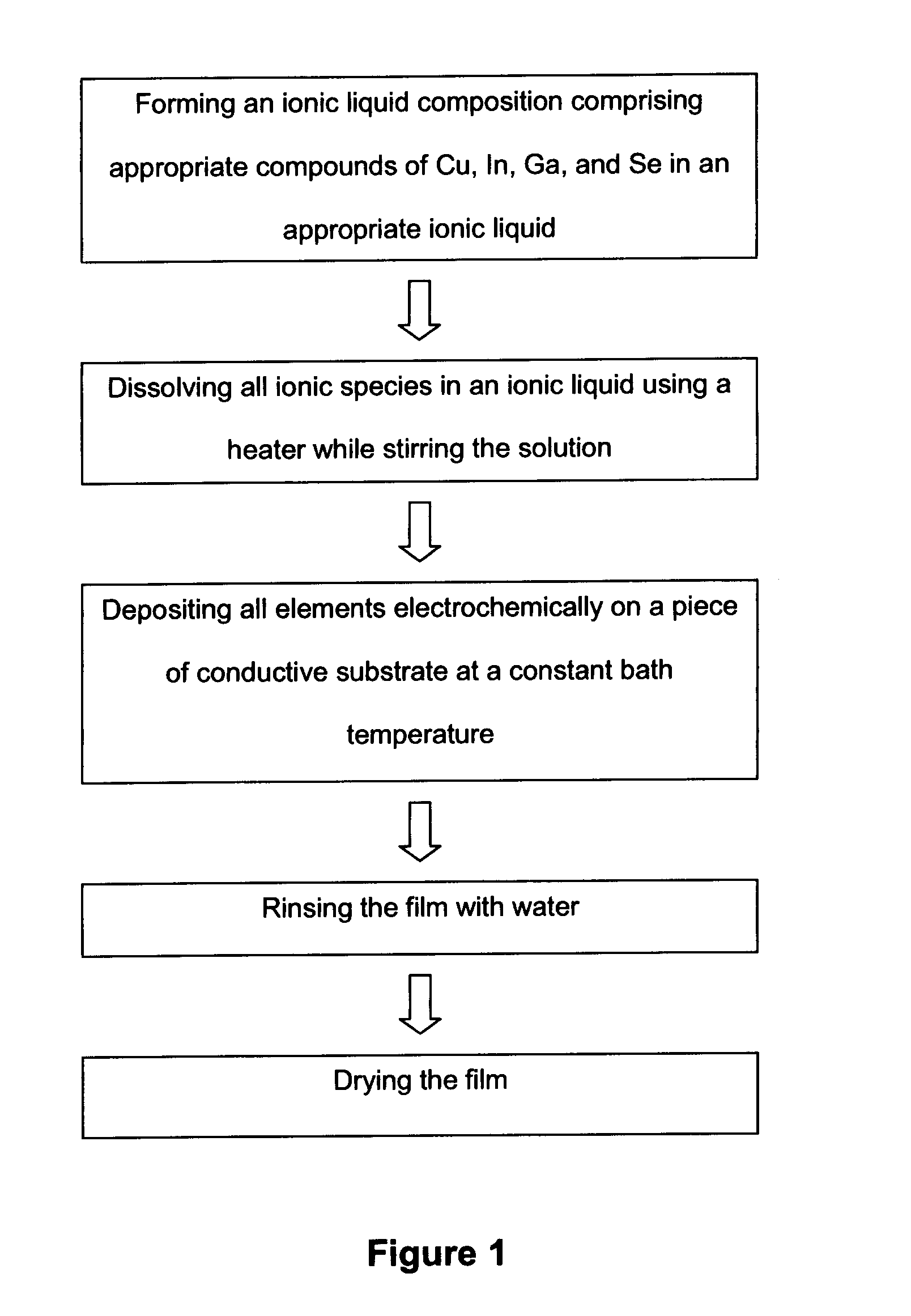Electrochemical method of producing copper indium gallium diselenide (CIGS) solar cells
a solar cell and indium gallium diselenide technology, applied in the direction of sustainable manufacturing/processing, final product manufacturing, basic electric elements, etc., can solve the problems of low efficiency of photovoltaic (pv) conversion, high capital and operation costs involved in these methods of fabrication, and current supply of solar cells only 0.015% of electricity globally. , to achieve the effect of low cost and high-throughput production, easy scaling up, and low capital investment and equipment operating costs
- Summary
- Abstract
- Description
- Claims
- Application Information
AI Technical Summary
Benefits of technology
Problems solved by technology
Method used
Image
Examples
example 1
[0057]This example involves electrochemical deposition of copper, indium, and selenium (CIS) on a substrate which can be any conductive or semiconductive material such as conductive polymers, metals (sheet), or deposited metals (such as but not limited to gold, molybdenum, calcium, vanadium, chromium, silver, cobalt, iron, palladium, aluminum) deposited on a piece of glass or plastic or something similar. The conditions of this deposition were: [CuCl2]=7.5 mM, [InCl3]=65 mM, and [SeCl4]=40 mM at 65° C. in an ionic liquid at a constant potential of −1.35 V. It is also possible to make CIS film using other eletrochemical techniques such as cyclic voltammetry.
[0058]While this Example 1 involved desposition of CIS and not CIGS, the confirmation of the production of stoichiometric CIS films by the present invention is important because it is the prerequisite of the production of CIGS films. In addition, CIS can also be used as a practical absorbing layer in solar cells.
example 2
[0059]This example involves electrochemical deposition of CIGS on ITO glass using an ionic liquid as a solvent where the following concentrations were used: [CuCl2]=7.5 mM, [InCl3]=55 mM, [GaCl3]=45 mM, [SeCl4]=60 mM. The process was under constant temperature at 65 ° C. for 150 minutes. Cyclic voltammetry was used with the potential range between −0.1 V and −2.0 V being applied to do the deposition. However, it is possible to do the stoichiometric deposition using other electrochemical techniques such as, but not limited to, applying a constant potential such as was done in Example 1. Some examples of film compositions are shown in Table 1. Samples 1-3, particularly Samples 2-3, have film compositions of Se / Cu very close to the ideal stoichiometric CIGS composition for solar cell production. Hence, the deposition conditions of them can be fine-tuned for the actual solar cell production requirements.
example 3
[0060]The method disclosed herein also provides a method for the fabrication of a solar cell using the CIGS film described in Example 2. After depositing CIGS film, the edges of the CIGS film were covered, and CdS and ZnO were electrodeposited in reline at 90° C. For CdS, the deposition was carried out with aqueous solutions of 0.45M cadmium sulfate, 0.15M thiourea, and 1.8M ammonium at 80° C. in a simple chemical bath. For ZnO, 0.1 M of zinc perchlorite and a constant potential of −1.5V was used. Then, ITO was deposited on zinc oxide film to complete the solar cell fabrication.
PUM
 Login to View More
Login to View More Abstract
Description
Claims
Application Information
 Login to View More
Login to View More - R&D
- Intellectual Property
- Life Sciences
- Materials
- Tech Scout
- Unparalleled Data Quality
- Higher Quality Content
- 60% Fewer Hallucinations
Browse by: Latest US Patents, China's latest patents, Technical Efficacy Thesaurus, Application Domain, Technology Topic, Popular Technical Reports.
© 2025 PatSnap. All rights reserved.Legal|Privacy policy|Modern Slavery Act Transparency Statement|Sitemap|About US| Contact US: help@patsnap.com



